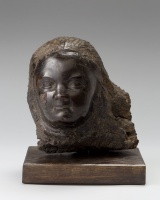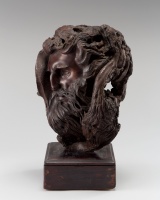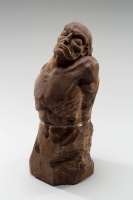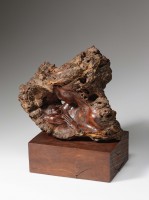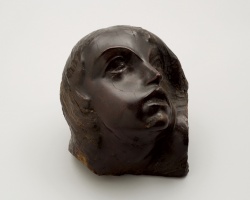
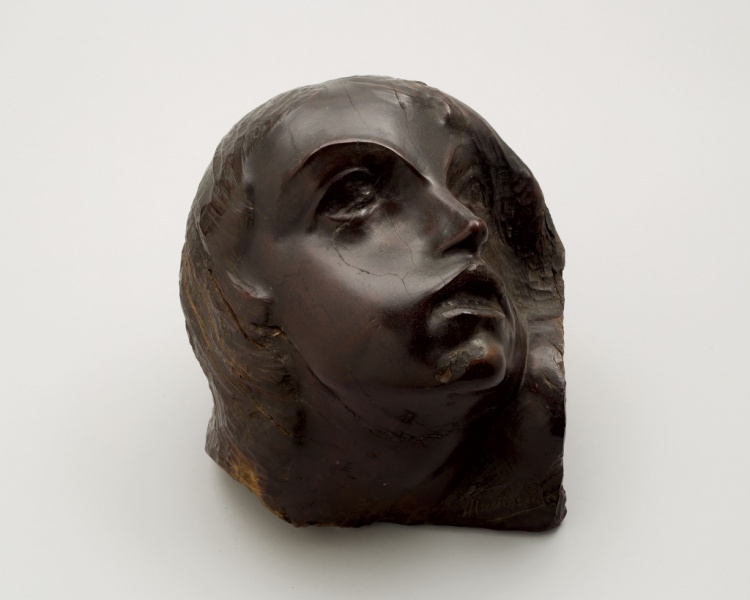
Woman's Head
| Author: |
Matas Menčinskas (1897–1942) |
| Created: | 1929-1933 |
| Material: | wood |
| Dimensions: | 29 × 39.50 cm |
Matas Mečislovas Menčinskas (1897–1942) is a classic of Lithuanian sculpture, and one of the most enigmatic personalities in modern art. His life, spanning Lithuania, Poland, Italy, Spain, Argentina, Uruguay, and back to Lithuania, shaped his unique style. Most of the sculptures in this collection can be attributed to his Argentinian period. Arriving in Argentina in 1928, Menčinskas enrolled in the National Academy of Fine Arts (Academia Nacional de Bellas Artes), where he studied under several different sculptors. He was influenced most by the Mordvin sculptor Stepan Nefyodov-Erzia, who had connections with Rodin’s circle of artists. Erzia began working with the local material quebracho in 1928. Menčinskas worked in his studio for a while, and, under the influence of his work, changed from the Classical school to Modernism. He also learned the intricacies of working with quebracho from Erzia. According to the press at the time, Menčinskas’ teacher was mostly acclaimed for unveiling the new possibilities of the local Argentinian material quebracho.* Both Erzia and Menčinskas were pioneers in demonstrating the beauty and aesthetic properties of this wood. Critics noted that it was as if the nature of Argentina itself, rather than the sculptor, created the art. Woman’s Head is also made of quebracho, a wood known for its expressive texture and exceptional hardness, which is often referred to as black marble. This luxurious wood, which gains a special lustre after polishing, was ideally suited to the refined aesthetics of Art Deco. The stylistic features of Menčinskas’ sculpture, the modelling of the face and the treatment of the hairstyle, are closely related to Erzia’s 1930 work Modern Girl (Chica moderna).
Text author Jurgita Ludavičienė
* Laura Petrauskaitė. Matas Menčinskas ir jo amžininkai: menininkų migracijos reikšmė 20 a. pirmos pusės Lietuvos dailės modernizacijai. Vilnius, 2019, p. 145.
Matas Menčinskas (1897–1942), a sculptor who worked in Lithuania in the interwar years, stood out clearly with his original style. He enrolled at Kaunas Art School in 1922 before the sculpture studio opened there, and soon started to look for opportunities to study abroad. He eventually went to Barcelona, Madrid and Buenos Aires, where he became interested in the work of Stepan Erzia, a sculptor of Mordovian origin, which had a direct influence on his style and on his choice of material (such as quebracho wood). Menčinskas began carving symbolic compositions and sculptures, mostly busts. Financial hardship and failing health made him return to Lithuania in 1934. His unusual pieces carved out of wood are distinguished by their technical skill and expressive power, which were untypical of local sculptors in the 1930s, who worked mainly in clay, gypsum and bronze. However, he did not avoid the influence of Art Deco either, and created figures in Neoclassical forms, as well as high-quality salon-style compositions in gypsum.
Text authors Dovilė Barcytė and Ieva Burbaitė
Source: Law firm Valiunas Ellex art album KAUNAS–VILNIUS / 1918–1945 (2021). Compilers and text authors Dovilė Barcytė and Ieva Burbaitė, THE ART OF MATERIALS. Compiler and text author Jurgita LudavičienėExpositions: "A Glance at the History of Lithuanian Art from Užupis", 30 August 2018 – 1 June 2019, Lithuanian Art Centre TARTLE (Užupio St. 40, Vilnius). Curator Giedrė Jankevičiūtė.








